C/C++编程笔记:链接列表(链表)丨插入节点的三种方法
在上一篇文章中,我们介绍了链接列表。我们还创建了一个具有3个节点的简单链表,并讨论了链表遍历。
本文讨论的所有程序均考虑以下链表的表示形式。
C ++

C

在这篇文章中,讨论了在链表中插入新节点的方法。可以通过三种方式添加节点:
1)在链表的最前面
2)在给定节点之后。
3)在链接列表的末尾。
在前面添加一个节点:(4个步骤)
将新节点始终添加到给定链接列表的开头之前。新添加的节点成为链接列表的新头。例如,如果给定的链接列表为10-> 15-> 20-> 25,并且我们在前面添加了项目5,则链接列表将变为5-> 10-> 15-> 20-> 25。让我们将添加到列表最前面的函数称为push()。push()必须接受一个指向头指针,因为必须推头指针改为指向新的节点。
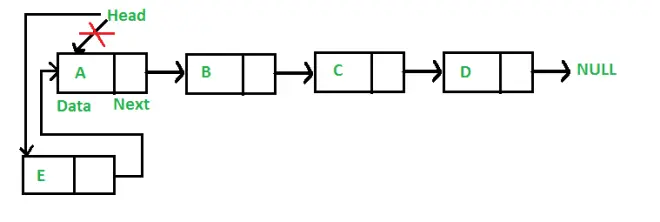
以下是在最前面添加节点的4个步骤。
C++
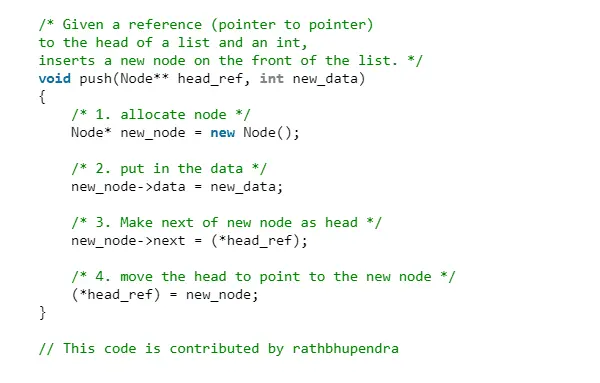
C
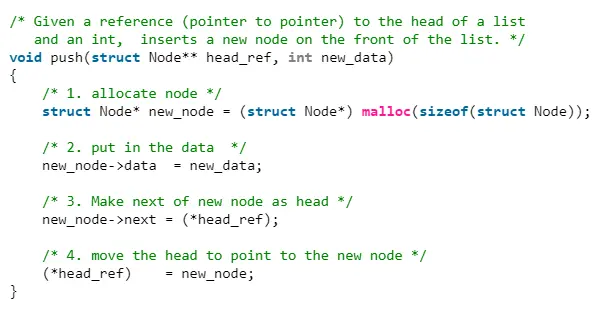
push()的时间复杂度为O(1),因为它要做的工作量是恒定的。
在给定节点之后添加一个节点:(5个步骤)
给我们一个指向节点的指针,并将新节点插入到给定节点之后。
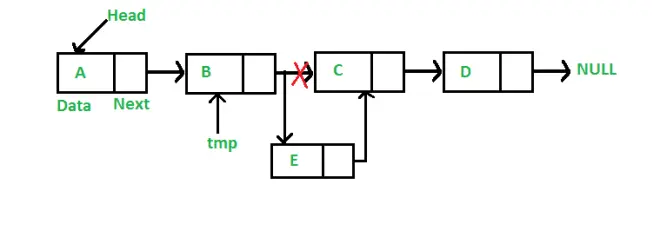
C ++
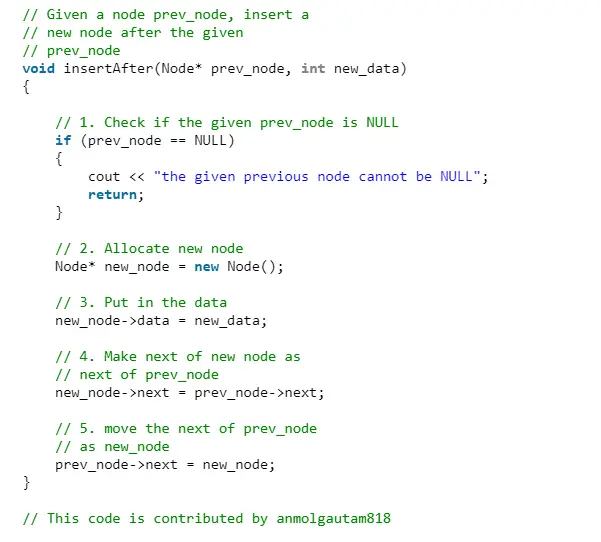
C
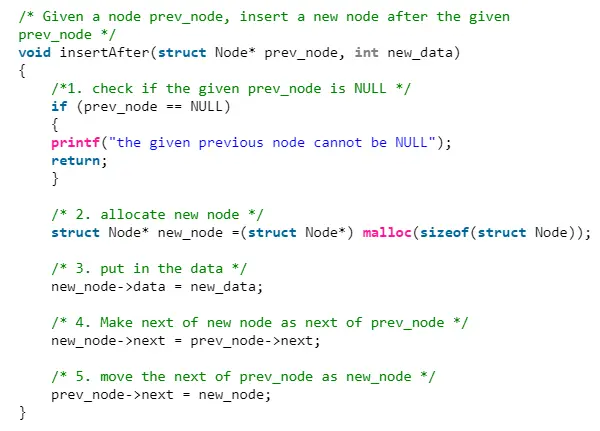
insertAfter()的时间复杂度为O(1),因为它的工作量是恒定的。
在最后添加一个节点:(6个步骤)
将新节点始终添加到给定链接列表的最后一个节点之后。例如,如果给定的链接列表为5-> 10-> 15-> 20-> 25,并且我们在末尾添加了项目30,则链接列表将变为5-> 10-> 15-> 20-> 25- > 30。
由于链接列表通常由其头部表示,因此我们必须遍历该列表直至结束,然后将最后一个节点的下一个更改为新节点。

以下是最后添加节点的6个步骤。
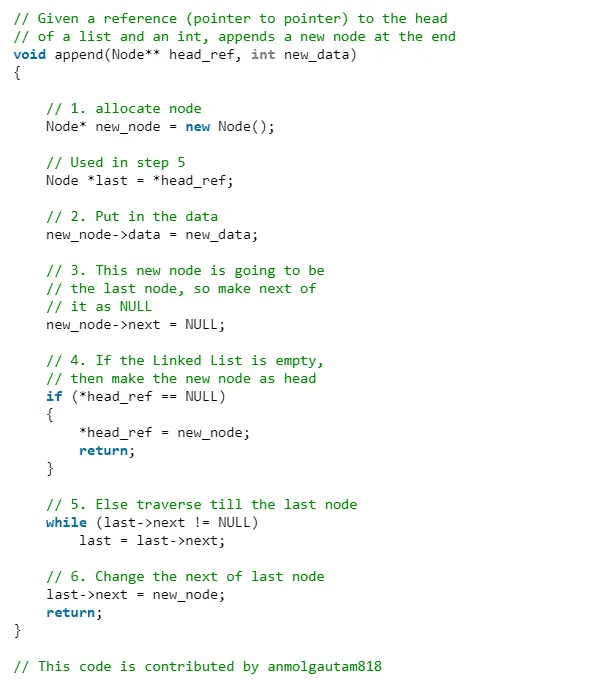
C
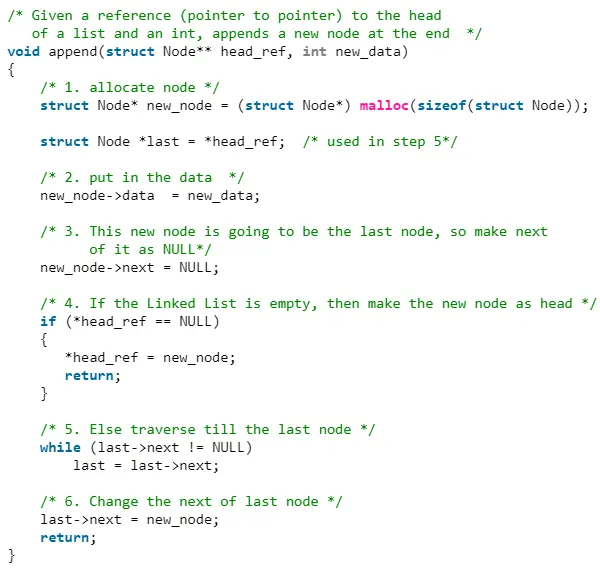
append的时间复杂度为O(n),其中n是链表中节点的数量。由于从头到尾都有一个循环,因此该函数可以执行O(n)。
还可以通过保留指向链表尾部的额外指针,将该方法优化为在O(1)中工作。
以下是使用上述所有方法创建链表的完整程序。
C ++
#include <bits/stdc++.h>
usingnamespacestd;
classNode
{
public:
intdata;
Node *next;
};
voidpush(Node** head_ref, intnew_data)
{
Node* new_node = newNode();
new_node->data = new_data;
new_node->next = (*head_ref);
(*head_ref) = new_node;
}
voidinsertAfter(Node* prev_node, intnew_data)
{
if(prev_node == NULL)
{
cout<<"the given previous node cannot be NULL";
return;
}
Node* new_node = newNode();
new_node->data = new_data;
new_node->next = prev_node->next;
prev_node->next = new_node;
}
voidappend(Node** head_ref, intnew_data)
{
Node* new_node = newNode();
Node *last = *head_ref; /* used in step 5*/
new_node->data = new_data;
new_node->next = NULL;
then make the new node as head */
if(*head_ref == NULL)
{
*head_ref = new_node;
return;
}
while(last->next != NULL)
last = last->next;
last->next = new_node;
return;
}
voidprintList(Node *node)
{
while(node != NULL)
{
cout<<" "<<node->data;
node = node->next;
}
}
int main()
{
Node* head = NULL;
append(&head, 6);
push(&head, 7);
push(&head, 1);
append(&head, 4);
insertAfter(head->next, 8);
cout<<"Created Linked list is: ";
printList(head);
return 0;
}
C语言
#include <stdio.h>
#include <stdlib.h>
structNode
{
intdata;
structNode *next;
};
voidpush(structNode** head_ref, intnew_data)
{
structNode* new_node = (structNode*) malloc(sizeof(structNode));
new_node->data = new_data;
new_node->next = (*head_ref);
(*head_ref) = new_node;
}
voidinsertAfter(structNode* prev_node, intnew_data)
{
/*1. check if the given prev_node is NULL */
if(prev_node == NULL)
{
printf("the given previous node cannot be NULL");
return;
}
structNode* new_node =(structNode*) malloc(sizeof(structNode));
new_node->data = new_data;
new_node->next = prev_node->next;
prev_node->next = new_node;
}
voidappend(structNode** head_ref, intnew_data)
{
structNode* new_node = (structNode*) malloc(sizeof(structNode));
structNode *last = *head_ref; /* used in step 5*/
new_node->data = new_data;
it as NULL*/
new_node->next = NULL;
if(*head_ref == NULL)
{
*head_ref = new_node;
return;
}
while(last->next != NULL)
last = last->next;
last->next = new_node;
return;
}
voidprintList(structNode *node)
{
while(node != NULL)
{
printf(" %d ", node->data);
node = node->next;
}
}
intmain()
{
structNode* head = NULL;
append(&head, 6);
push(&head, 7);
push(&head, 1);
append(&head, 4);
insertAfter(head->next, 8);
printf("\n Created Linked list is: ");
printList(head);
return0;
}
输出:
创建的链接列表为:1 7 8 6 4
希望本篇文章对你有帮助~
另外如果你想更好的提升你的编程能力,学好C语言C++编程!弯道超车,快人一步!笔者这里或许可以帮到你~

UP在主页上传了一些学习C/C++编程的视频教程,有兴趣或者正在学习的小伙伴一定要去看一看哦!会对你有帮助的~
分享(源码、项目实战视频、项目笔记,基础入门教程)
欢迎转行和学习编程的伙伴,利用更多的资料学习成长比自己琢磨更快哦!
编程学习书籍分享:

编程学习视频分享:


